What do cleaning your dryer vent and working your rotator cuffs have in common? They’re both easy to forget about until there’s a problem! Just like your dryer can start a fire if lint isn’t cleaned out of the vent for a while, your rotator cuffs can tear and ache if they aren’t worked regularly. It’s important to take preventative measures in both cases — which is what the Cuban press is for (Sorry, it won’t help with your dryer lint problem).
The Cuban press combines three different movements into one exercise. This movement has many purposes besides strengthening your rotator cuffs. It can also better your posture, improve flexibility, and help you stay injury-free, as it’s a prehab exercise.
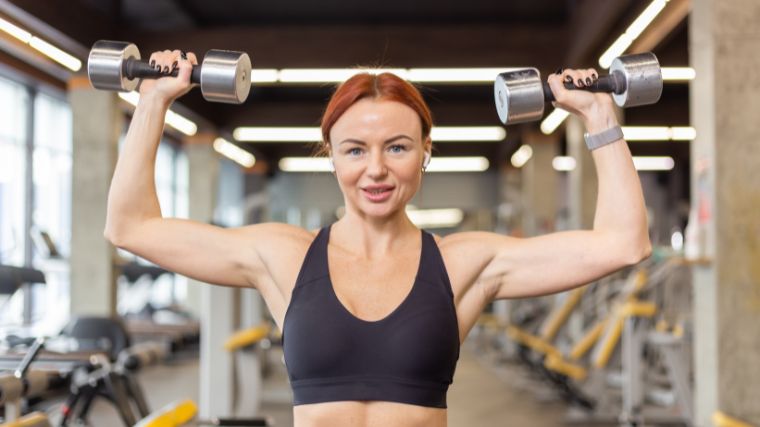
Want to learn more about the Cuban press? You’ve come to the right place. This guide will teach you how to do it, how it works, and other methods of bulletproofing your shoulders.
- How to Do the Cuban Press
- Cuban Press Variations
- Cuban Press Alternatives
- Cuban Press Tips
- Cuban Press Sets and Reps
- Benefits of the Cuban Press
- Muscles Worked by the Cuban Press
- Who Should Do the Cuban Press
- Common Cuban Press Mistakes
- Frequently Asked Questions
How to Do the Cuban Press
The Cuban press is a three-part movement. You’ll do an upright row, externally rotate your shoulders, then perform an overhead press. For this exercise, everyone should use between 5-10-pound dumbbells (but you’re welcome to use no weight at all as you’re mastering the movement pattern).
Step 1 — Bring Your Elbows Up
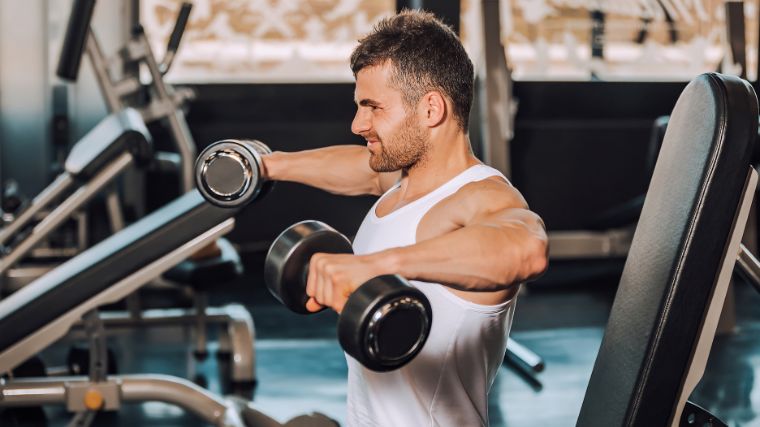
Grab light dumbbells in both hands and start with your wrists forward. Next, bring your elbows up to a 90-degree angle, ensuring they are parallel to the floor.
Coach’s Tip: Set your scapula before performing a Cuban press, as this can help you prevent unnecessary shoulder movements (which can result in injury).
Step 2 — Rotate Externally
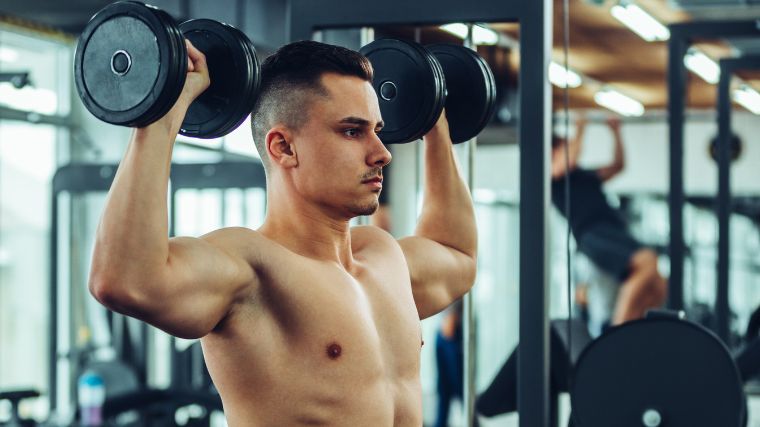
Rotate externally from your shoulders (technically known as the infraspinatus (1) muscles) so that your arms look like they’re in a goalpost position.
Coach’s Tip: Don’t fling your hands backward to rotate. Focus on moving from your shoulders to get the full benefit of the movement.
Step 3 — Press Upwards
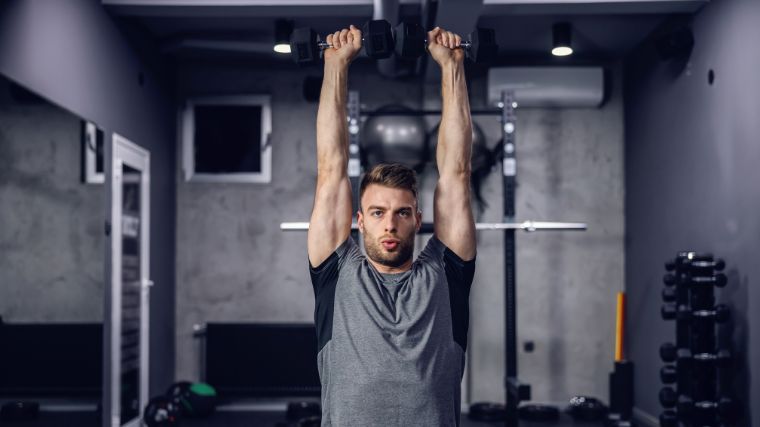
Press your arms overhead, ensuring your body stays straight. Make sure to keep your core engaged as you press.
Coach’s Tip: The dumbbells don’t need to go backward or forwards when you press. Simply press up straight (your hands should be over the middle of your head).
Cuban Press Variations
Want to do something like the Cuban press on your next shoulder day (but not it exactly)? Here are three great variations for all levels–beginner, intermediate, and advanced.
Cuban Rotation
Grab the lightweight dumbbells you’d traditionally use for a Cuban press (between 3-10 pounds) and start with one in each hand. Bring your arms into a goalpost position with your elbows at a 90-degree angle.
[Read More: Build Big Shoulders With This Supplementary Shoulder Workout Routine]
From there, internally rotate your shoulders (keeping your elbows bent at 90 degrees) until your wrists face forward. This is a great exercise to improve shoulder mobility and can be less confusing for a beginner than a traditional Cuban press.
Barbell Cuban Press
Instead of grabbing dumbbells for the Cuban press, this variation uses a barbell (as the name implies) with no plates. To perform this movement, grasp the barbell overhand, spacing your grip about three inches from the outside of your shoulders. Next, upright row the bar, keeping your elbows in a 90-degree position.
[Read More: The 15 Best Barbell Exercises For Mass, Strength, And Power]
Externally rotate from your shoulders as usual before pressing up overhead into a ‘V’ position. You’ll then bring your arms back into a goalpost position before internally rotating. If you’ve mastered a Cuban press with dumbbells, this is the next step for advancement.
Lying Dumbbell Cuban Press
Although this is the most advanced of the three variations, you’ll use even lighter weights for the lying dumbbell Cuban press than either of the others. Choose very light plates (1.5-5 pounds) that you might use for I’s, Y’s and T’s.
Grab an incline bench and straddle the seat, resting your stomach on the back of the bench. Hold one plate in both hands with your wrists facing forward. From there, move your elbows to a 90-degree angle before externally rotating from your shoulders. You’ll then press into a ‘V’ shape before bringing the weights back to a 90-degree angle and internally rotating.
Cuban Press Alternatives
Looking for some alternatives to the Cuban press? Here are three excellent options if you want something a little different:
Standing Dumbbell I-Y-T
To perform this exercise, you’ll need two light weights (similar to that of the Cuban press). From there, hold the weights in each hand with your wrists facing forward. Lift your arms straight forward to perform the ‘I’ portion of this movement.
You’ll then bring your arms back to their starting position before moving your arms to a ‘V’ position in front of your body. After bringing your arms back down, move them into a ‘T’ position on either side of your body, being careful not to raise your arms higher than your shoulders.
Similarly to the Cuban press, the standing dumbbell I-Y-T requires you to retract your scapula to stabilize yourself. It also targets the shoulders and upper back, much like the Cuban press.
Battle Rope Double Waves
To do battle rope double waves, you’ll need two battle ropes (shocker) anchored to the wall or a sturdy, immovable object. From there, grab the ends of the ropes with both hands about shoulder-width apart. Get down into a half squat and raise and lower both arms at the same time to make waves with the ropes.
[Read More: The Best Battle Rope Exercises For Battle-Ready Grip Strength And Conditioning]
This movement is similar to the Cuban press because it activates your shoulders and upper body.
Arnold Press
To do an Arnold press, grab a set of moderate dumbbells in an underhand grip. From there, raise your dumbbells to be in front of your face with your elbows bent. Brace your core and press, rotating your hands as you move upwards. You should end up in a traditional overhead press. Bring your arms back down to your starting position.
[Read More: The Best Shoulder Exercises and Workouts]
Similarly to the Cuban press, the Arnold press targets the shoulders and upper body (and involves a press).
Cuban Press Tips
To maximize your value from the Cuban press, you should always strive for pristine technique. Make sure to lead with your elbows, find right angles in your arms, and work with light weights exclusively.
Lead With Your Elbows
When you initiate the Cuban press, think about pulling upward with your elbows. This should help keep your forearms pointing directly at the floor, emphasizing internal rotation at the shoulder. An internally-rotated shoulder also means the weights you’re holding stay nice and close to your body.
Aim For Right Angles
When you rotate your arms upward during the Cuban press, aim for a perfect right angle in your arm and relative to your torso. This should help you maintain good posture, activate the appropriate musculature, and improve your pressing power.
Start (and Stay) Light
The Cuban press contains three distinct phases. You perform an upright row, rotate your arms upward, and then do a standard overhead press. The first and third phases are far easier and safer to load than the transitional phase.

When performing any complex movement, you’re only as strong as the weakest part of your range of motion. As such, to keep your shoulders safe and healthy, you’re going to have to work with relatively light weights.
Cuban Press Sets and Reps
The Cuban press is interesting in that it’s an accessory movement not intended to help you build muscle mass–rather, it is meant to strengthen and stabilize your rotators. Think of it as prehab, if you will.
- For Beginners: Perform three sets of six reps. Use light weight (around 3-5 pounds), a PVC pipe, or nothing at all.
- For Advanced Athletes: Do three sets of 15-20 reps. Choose a light weight (between 5-10 pounds).
Benefits of the Cuban Press
If you always want to know the ‘why’ behind certain exercises, you’re not alone. Here are the benefits of adding the Cuban press into your routine:
Stronger Shoulders
The Cuban press works the rotator cuff, which is crucial for shoulder stability and health. Additionally, the three heads of the delt are used, which leads to more stable (and stronger) shoulders.
Better Mobility
Besides increasing your shoulder’s range of motion (ROM), the Cuban press also helps your upper back become more mobile. Additionally, this exercise can help warm-up your joints by taking your shoulders through an exceptional portion of their range of motion.
It’s Time-Efficient
This exercise works all three heads of the delt, which makes it a good exercise for those short on time. And although this isn’t an exercise you should go heavy on, it’s a great all-in-one easy to warm up fairly quickly before moving on to the main events (maybe overhead presses or clean and presses, perhaps?).
Muscles Worked by the Cuban Press
Curious what muscles are worked by the Cuban press? Here are the four main ones:
Rotator Cuff
The rotator cuff stabilizes the shoulder joint so that you can move both your arm and shoulder. And although modern surgeries (2) are improving for those who tear or severely injure their rotator cuff, the best way to stay healthy is to do preventative exercises (like the Cuban press) to strengthen the surrounding muscles.
Deltoid
The deltoid includes three separate components (3): The posterior, anterior, and lateral deltoids. Each head has a different function. The posterior deltoid helps you extend your arm, the lateral delt helps you lift it, and the anterior delt helps you flex and adduct the arm.
Traps
The traps help your neck, shoulders, and head stay stable during exercises, but more importantly, they work in tandem with the scapula. Having strong traps also allows you to have better posture and avoid rounded shoulders.
Who Should Do the Cuban Press
Trying to figure out if you should add Cuban presses to your routine? Here are three types of people who should give this movement a go:
Olympic Lifters
Olympic lifters perform repetitive movements that heavily involve the shoulders (snatch, clean and press and clean and jerk), but they need to also move in ways that stabilize and activate the shoulders, too. The Cuban press is an excellent prehab exercise that warms up the shoulders, helps prevent injuries, and improves mobility.
Inflexible People
The Cuban press works on the mobility of the shoulders, which can be beneficial for those who have inflexible rotator cuffs. Additionally, it can help you get better ROM in your upper back, which can improve performance with other exercises.
People Warming Up
The Cuban press can help you be better/more mobile at things like push-ups, pull-ups, and more. It strengthens often-forgotten muscles and restores blood flow, which makes it a great warm-up or prehab exercise.
Common Cuban Press Mistakes
As with any exercise, mistakes are a dime a dozen with the Cuban press. You can easily use weights that are too heavy for the movement without even knowing it, move too fast, or have your body in the wrong position.
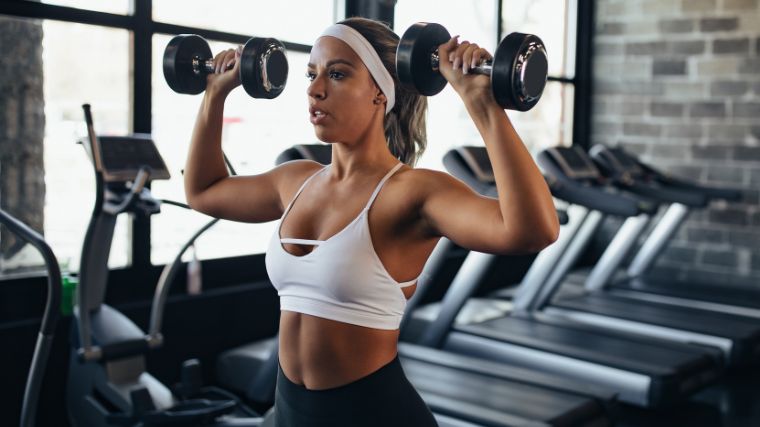
And since your safety is a priority, elaborating on the three most common mistakes seen with the Cuban Press are, too. Check them out:
Picking Heavy Weights
If you choose a weight that is too heavy (over 10 pounds per hand), you may not be able to get a proper range of motion, eliminating the point of this exercise. This movement helps work smaller muscles (like the rotator cuff) that may not typically be worked on during other shoulder exercises, and using too heavy of weight could damage or tear the muscles.
Not Setting Your Scapula
If you don’t set your shoulder blades before doing a Cuban Press, you’re not properly stabilizing your shoulders (which is an injury risk). To set your scapula, move your shoulder blades back and down–yes, it is that simple!
Going Too Fast
Slow and controlled is the name of the game. If you fling your arms up during the overhead press, and swing your hands back during the external rotation or speed to drop the weight down, you aren’t getting the full benefit of the movement (and you may injure yourself). Try to stay at a steady pace throughout the exercise.
Are You Ready to Rumble?
Provided you don’t have an existing rotator cuff injury, the Cuban press can be beneficial for pretty much anyone. Add it to the beginning of a shoulder day to warm up, or use it for prehab/injury prevention. You’ll strengthen small muscles and improve overall mobility — what more could you ask for?
FAQs
Have questions about the Cuban press? Fear not! Answers abound.
How effective is the Cuban press?
‘Effective’ is a loaded word, but the Cuban press will help with the health and stability of your shoulders. While this is not a movement geared towards gaining muscle mass, it is still a beneficial movement to incorporate into your training.
Is the Cuban press good for the rotator cuff?
Yes, the Cuban press is good for the rotator cuff if you don’t have pre-existing issues and don’t go too heavy on the weight. If you have pre-existing rotator cuff issues, consult a licensed medical professional before attempting this movement.
Why is it called the Cuban press?
Canadian strength coach Charles Poliquin reportedly popularized this movement to get his lifters to strengthen their shoulders. He supposedly called this movement “the Cuban press” because he claimed this was the movement Cuban lifters used for their shoulders.
References
- Wu JG, Bordoni B. Anatomy, Shoulder and Upper Limb, Scapulohumeral Muscles. [Updated 2023 May 19]. In: StatPearls [Internet]. Treasure Island (FL): StatPearls Publishing; 2023 Jan-.
- Sambandam SN, Khanna V, Gul A, Mounasamy V. Rotator cuff tears: An evidence based approach. World J Orthop. 2015 Dec 18;6(11):902-18.
- Elzanie A, Varacallo M. Anatomy, Shoulder and Upper Limb, Deltoid Muscle. [Updated 2023 May 8]. In: StatPearls [Internet]. Treasure Island (FL): StatPearls Publishing; 2023 Jan-
Featured Image: Vladimir Sukhachev / Shutterstock